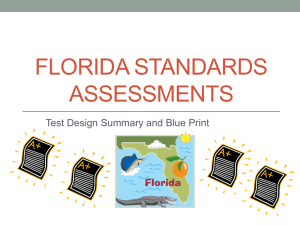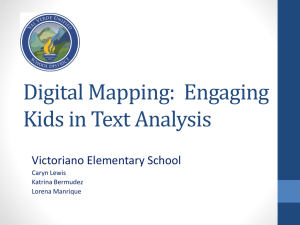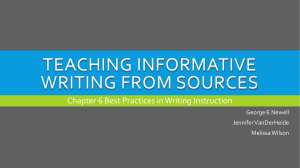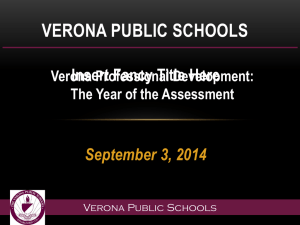Preparing for Elementary Math
advertisement
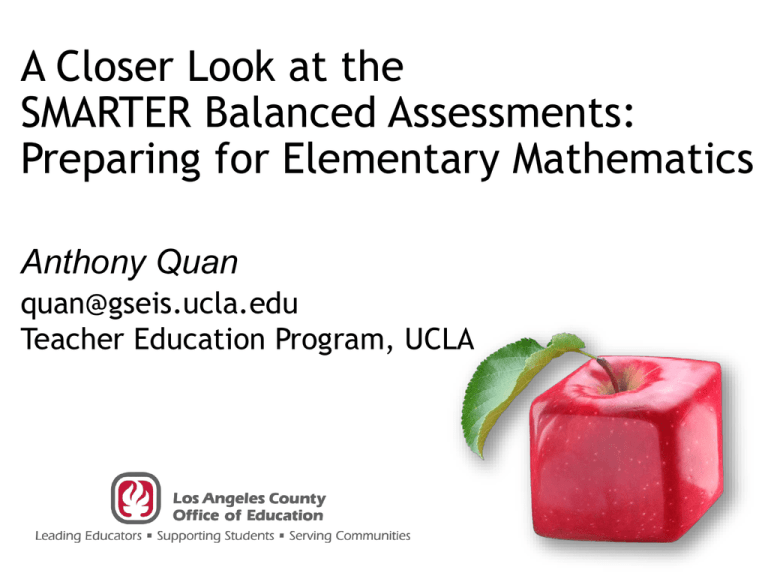
A Closer Look at the SMARTER Balanced Assessments: Preparing for Elementary Mathematics Anthony Quan quan@gseis.ucla.edu Teacher Education Program, UCLA Agenda: Item Types Depth of Knowledge Technology Next Steps Try This Assessment Items • • • • • • Multiple choice/Selected response Short-answer Constructed response Extended response Performance Events Technology-enhanced Depth of Knowledge “He who learns but does not think, is lost. He who thinks, but does not learn is in great danger.” Confucious Depth of Knowledge (DOK) No Child Left Behind (NCLB) requires assessments to “measure the depth and breadth of the state academic content standards for a given grade level”. (U.S. Department of Education, 2003, p. 12) What is Depth of Knowledge (DOK)? • A scale of cognitive demand (thinking) to align standards with assessments • Based on the research of Norman Webb, University of Wisconsin Center for Education Research and the National Institute for Science Education • Defines the “ceiling” or highest DOK level for each Core Content standard for the state assessment • Guides item development for state assessments DOK is about complexity • The intended student learning outcome determines the DOK level. • Every objective in the science and mathematics frameworks has been assigned a DOK level. • Instruction and classroom assessments must reflect the DOK level of the objective or intended learning outcome. Depth of Knowledge • Level 1 • Conduct basic mathematical calculations • Label locations • Perform routine procedures • RECALL • Determine the perimeter or area of rectangles given a drawing or labels Depth of Knowledge Depth of Knowledge • Level Two • Solve routine multiple-step problems • Identify patterns • Organize, represent and interpret data • SKILLS AND/OR CONCEPT • Classify plane and three dimensional figures Depth of Knowledge • Level Three • Apply a concept in other contents • Support ideas with details and examples • STRATEGIC THINKING • Solve a multiple-step problem and provide support with a mathematical explanation that justifies the answer Depth of Knowledge • Level Four • Apply mathematical model to illuminate a problem or situation. • Analyze and synthesize information from multiple sources • Design a mathematical model to inform and solve a practical or abstract situation • EXTENDED THINKING Depth of Knowledge • So what is the point of knowing Depth of Knowledge? • This helps us understand what the outcomes of our lessons should be. • We need to prepare students to think more conceptually Making Sense & Worthwhile Tasks “What are our Kids really being asked to do?” “How are we keeping up with Cognitive Demand?” Why Depth of Knowledge? Mechanism to ensure that the intent of the standard and the level of student demonstration required by that standard matches the assessment items (required under NCLB) To ensure that teachers are teaching to a level that will promote student achievement DOK is NOT... • Bloom’s taxonomy • the same as difficulty • about using “verbs” DOK is about intended outcome, not difficulty DOK is a reference to the complexity of mental processing that must occur to answer a question, perform a task, or generate a product. • Adding is a mental process. • Knowing the rule for adding is the intended outcome that influences the DOK. • Once someone learns the “rule” of how to add, 4 + 4 is DOK 1 and is also easy. • Adding 4,678,895 + 9,578,885 is still a DOK 1 but may be more “difficult.” Let’s look at DOK in Math Activities Remember DOK is... …descriptive …focuses on how deeply a student has to know the content in order to respond …NOT the same as difficulty. …NOT the same as Bloom’s Taxonomy What is Computer Adaptive Testing (CAT)? • Adapts to the student’s ability level • Assessment “engine” delivers short series of moderately difficult grade items • Depending on student’s initial performance delivers items that are either more or less difficult • Process continues until student’s performance level is determined. Benefits of Computer Adaptive Testing (CAT) Faster results •Turnaround in weeks compared to months today Shorter test length •Fewer questions compared to fixed form tests Increased precision Tailored to student ability Greater security Mature technology •Provides accurate measurements of student growth over time • Item difficulty based on student responses •Larger item banks mean that not all students receive the same questions •GMAT, GRE, COMPASS (ACT), Measures of Academic Progress (MAP) 27 Tablets vs. Computers • There are current challenges to test item security for online assessment with tablets, ereaders, and smartphones. • Testing software used by computers typically shuts down keyboard commands, such as “print screen” and “copy,” to ensure test security. Tablet applications don’t have this capability. • SBAC will conduct further development and testing. IT Technology Readiness Tool • Online dynamic and interactive technology readiness tool • Helps SEAs and LEAs evaluate current technology and infrastructure in terms of SBAC implementation readiness • It is anticipated tool will be ready in spring 2012 • NCS Pearson will develop System Portal for Online Delivery • System Portal contains information about Common Core State Standards, Consortium activities, web-based learning communities, and assessment results • Dashboard gives parents, students, practitioners, and policymakers access to assessment information • Reporting capabilities include static and dynamic reports, secure and public views • Item development and scoring application support educator participation in assessment • Feedback and evaluation mechanism provides surveys, open feedback, and vetting of materials Digital Etiquette • Are there suggestions for preparing technology enhanced responses? • YES. Let’s take a look at what can be done. *According to the Common Core, “The standards require that students gain, evaluate, and present increasingly complex information, ideas, and evidence through listening and speaking as well as through media.” *With media taking a prominent role in both the gathering of information and the presentation of new knowledge products, it is recommended that schools be equipped with: • projection/presentation stations • internet connectivity • media creation stations • writing centers • internet stations to support distance learning course offerings • video and still cameras with computer software for media production ***Recommendations from the NYLA (New York Librarian Association) By embracing technology and encouraging students to explore its various forms, educators also have a responsibility to teach students to use technology in a responsible manner. 2 Things To Remember… Digital Citizenship will be constantly changing with the times as new tools are developed and used. As within any society, we need a structure which people need to honor so that we are respectful to each other. How Do We Start Implementing Digital Citizenship In Our Classrooms and Where Can We Find Support ? • • • • • • • http://cybercitizenship.ning.com http://www.onguardonline.gov http://GetNetWise.org http://CommonSenseMedia.org http://iKeepSafe.org - Parents http://NetSmarts.org http://WiredSafety.org Technology in the Classroom • Banana Hunt (cool-mathgames.com) • Adopted materials • Geogebra (geogebra.org) Equity Issues • • • • Availability of Technology Accessibility of Technology Integrating Technology into the curriculum Teacher knowledge and comfort




